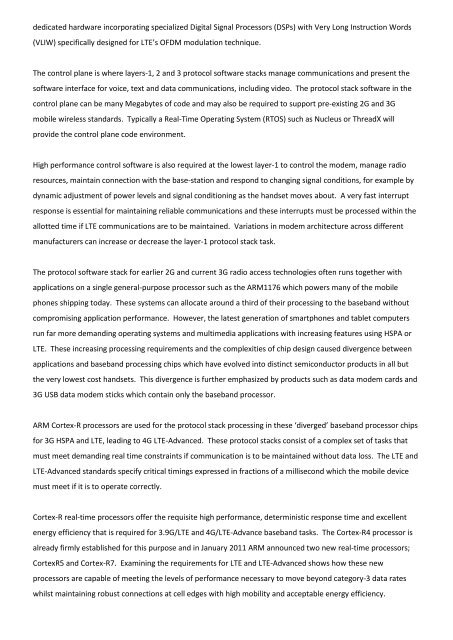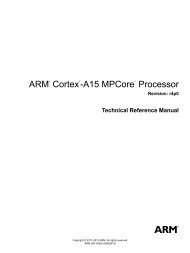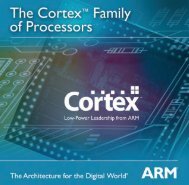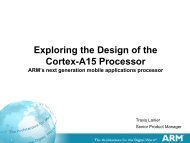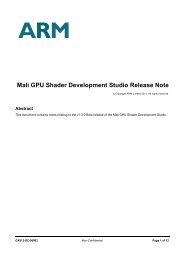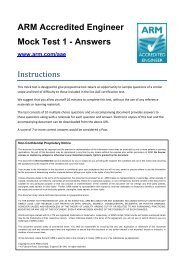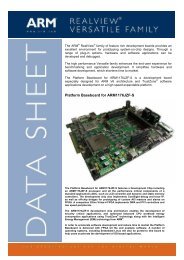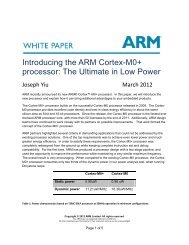New Cortex-R Processors for LTE and 4G Mobile Baseband - ARM
New Cortex-R Processors for LTE and 4G Mobile Baseband - ARM
New Cortex-R Processors for LTE and 4G Mobile Baseband - ARM
- No tags were found...
You also want an ePaper? Increase the reach of your titles
YUMPU automatically turns print PDFs into web optimized ePapers that Google loves.
dedicated hardware incorporating specialized Digital Signal <strong>Processors</strong> (DSPs) with Very Long Instruction Words(VLIW) specifically designed <strong>for</strong> <strong>LTE</strong>’s OFDM modulation technique.The control plane is where layers-1, 2 <strong>and</strong> 3 protocol software stacks manage communications <strong>and</strong> present thesoftware interface <strong>for</strong> voice, text <strong>and</strong> data communications, including video. The protocol stack software in thecontrol plane can be many Megabytes of code <strong>and</strong> may also be required to support pre-existing 2G <strong>and</strong> 3Gmobile wireless st<strong>and</strong>ards. Typically a Real-Time Operating System (RTOS) such as Nucleus or ThreadX willprovide the control plane code environment.High per<strong>for</strong>mance control software is also required at the lowest layer-1 to control the modem, manage radioresources, maintain connection with the base-station <strong>and</strong> respond to changing signal conditions, <strong>for</strong> example bydynamic adjustment of power levels <strong>and</strong> signal conditioning as the h<strong>and</strong>set moves about. A very fast interruptresponse is essential <strong>for</strong> maintaining reliable communications <strong>and</strong> these interrupts must be processed within theallotted time if <strong>LTE</strong> communications are to be maintained. Variations in modem architecture across differentmanufacturers can increase or decrease the layer-1 protocol stack task.The protocol software stack <strong>for</strong> earlier 2G <strong>and</strong> current 3G radio access technologies often runs together withapplications on a single general-purpose processor such as the <strong>ARM</strong>1176 which powers many of the mobilephones shipping today. These systems can allocate around a third of their processing to the baseb<strong>and</strong> withoutcompromising application per<strong>for</strong>mance. However, the latest generation of smartphones <strong>and</strong> tablet computersrun far more dem<strong>and</strong>ing operating systems <strong>and</strong> multimedia applications with increasing features using HSPA or<strong>LTE</strong>. These increasing processing requirements <strong>and</strong> the complexities of chip design caused divergence betweenapplications <strong>and</strong> baseb<strong>and</strong> processing chips which have evolved into distinct semiconductor products in all butthe very lowest cost h<strong>and</strong>sets. This divergence is further emphasized by products such as data modem cards <strong>and</strong>3G USB data modem sticks which contain only the baseb<strong>and</strong> processor.<strong>ARM</strong> <strong>Cortex</strong>-R processors are used <strong>for</strong> the protocol stack processing in these ‘diverged’ baseb<strong>and</strong> processor chips<strong>for</strong> 3G HSPA <strong>and</strong> <strong>LTE</strong>, leading to <strong>4G</strong> <strong>LTE</strong>-Advanced. These protocol stacks consist of a complex set of tasks thatmust meet dem<strong>and</strong>ing real time constraints if communication is to be maintained without data loss. The <strong>LTE</strong> <strong>and</strong><strong>LTE</strong>-Advanced st<strong>and</strong>ards specify critical timings expressed in fractions of a millisecond which the mobile devicemust meet if it is to operate correctly.<strong>Cortex</strong>-R real-time processors offer the requisite high per<strong>for</strong>mance, deterministic response time <strong>and</strong> excellentenergy efficiency that is required <strong>for</strong> 3.9G/<strong>LTE</strong> <strong>and</strong> <strong>4G</strong>/<strong>LTE</strong>-Advance baseb<strong>and</strong> tasks. The <strong>Cortex</strong>-R4 processor isalready firmly established <strong>for</strong> this purpose <strong>and</strong> in January 2011 <strong>ARM</strong> announced two new real-time processors;<strong>Cortex</strong>R5 <strong>and</strong> <strong>Cortex</strong>-R7. Examining the requirements <strong>for</strong> <strong>LTE</strong> <strong>and</strong> <strong>LTE</strong>-Advanced shows how these newprocessors are capable of meeting the levels of per<strong>for</strong>mance necessary to move beyond category-3 data rateswhilst maintaining robust connections at cell edges with high mobility <strong>and</strong> acceptable energy efficiency.


